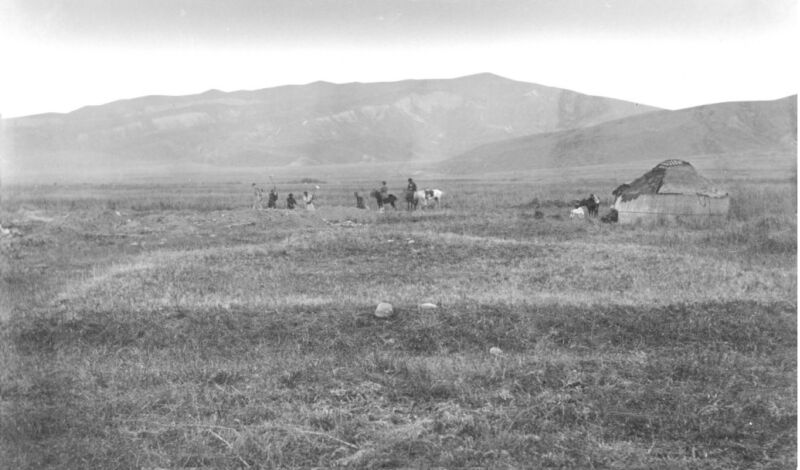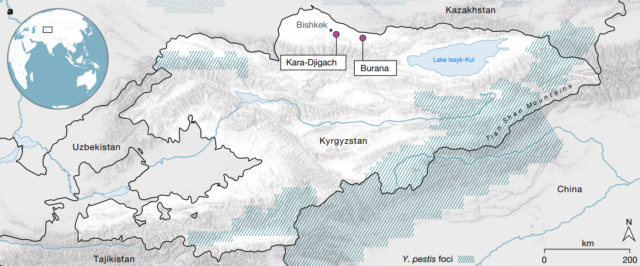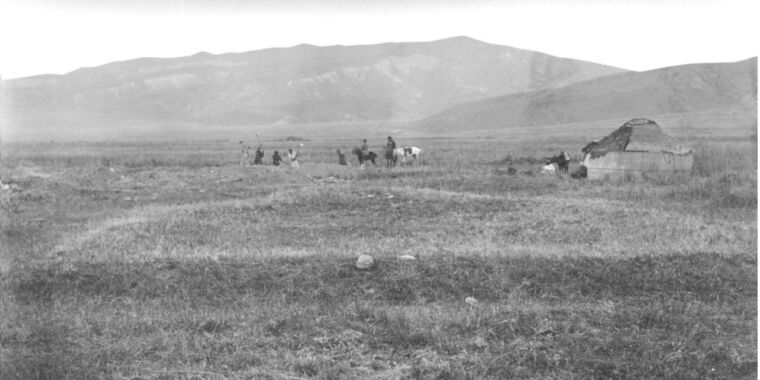
Spyrou et al. 2022
In 1338 and 1339, people were dying in droves in the villages around Lake Issyk-Kul in what’s now northern Kyrgyzstan. Many of the tombstones from those years blame the deaths on a generic “pestilence.” According to a recent study of ancient bacterial DNA from the victims’ teeth, the pestilence that swept through the Kyrgyz villages was Yersinia pestis—the same pathogen that would cause the devastating Black Death in Europe just a few years later.
Ground zero for the Black Death?
In just five years, bubonic plague killed at least 75 million people in the Middle East, northern Africa, and Europe. Known as the Black Death, the cataclysm of 1346-1352 is still the most deadly pandemic in human history. But the Black Death was only the first devastating wave of what historians call the second plague pandemic: a centuries-long period in which waves of Y. pestis periodically burned through communities or whole regions. When English diarist Samuel Pepys wrote about the Great Plague of London in 1666, he was describing a later wave of the same pandemic that began in the mid-1300s with the Black Death. Centuries of life with the reality of the plague actually shaped the genetic diversity of modern European populations.
And like every pandemic, the second plague pandemic had to start somewhere.
Today, we know that the second plague pandemic reached Europe around 1348 aboard ships arriving in Italy from a Genoese trading colony called Kaffa (now the city of Theodosia) on the Black Sea. But the pandemic was already well underway by the time it spread to Europe.
Based on what we know about the ecology of Y. pestis, which spreads through the bites (and vomit) of infected fleas, history’s most devastating pandemic began when fleas jumped from their usual hosts—wild rodents such as marmots—to humans. Researchers have used historical records and genetic evidence to try to pinpoint where and when that spillover happened. So far, though, estimates span the whole breadth of Asia and a period of at least 150 years.
Two villages in northern Kyrgyzstan—Kara-Djigach and Burana—are compelling places to look. The timing fits; an unnamed “pestilence” killed unusually large numbers of people in the area just a few years before the Black Death struck Europe. And the location also makes sense; the area around Lake Issyk-Kul, called the Chüy Valley, had trade connections across Eurasia, making it a perfect crossroads for people, goods, and infectious disease.

Spyrou et al. 2022
Diagnosing a medieval epidemic
To test the idea, archaeologist Maria Spyrou of the Max Planck Institute for Evolutionary Anthropology and her colleagues needed to find out what had actually killed the victims of whatever was spreading in 1338-1339. So they sampled tissue from the teeth of seven “pestilence” victims and sequenced all of the DNA present in the teeth. That included not only human DNA from the victims but also DNA from bacteria they were carrying when they died.
When you die with a bacterial infection raging in your bloodstream, those bacteria leave their DNA and proteins behind in parts of your skeleton, especially bone marrow and tooth pulp. Archaeologists have used that fact to find ancient plague DNA at sites across Eurasia and recently to diagnose tuberculosis in a casualty of Mt. Vesuvius’ 79 CE eruption.
In Kyrgyzstan, Spyrou and her colleagues found segments of DNA from Yersinia pestis in the teeth of three people buried in the cemeteries around Lake Issyk-Kul; their tombstones said they had died during 1338 and 1339. That’s enough to link the previously unnamed 1338-1339 “pestilence” to the plague.
![This headstone belongs to a 1338 plague victim named Sanmaq (whose genome was not sequenced for the study). Its epitaph reads, in Syriac, “In the Year 1649 [1337-8 CE], and it was the Year of the Tiger. This is the tomb of the believer Sanmaq. [He] died of pestilence.”](https://cdn.arstechnica.net/wp-content/uploads/2022/06/Plague-inscription-from-the-Chu-Valley-region-in-Kyrgyzstan.-640x676.png)
Spyrou et al. 2022








